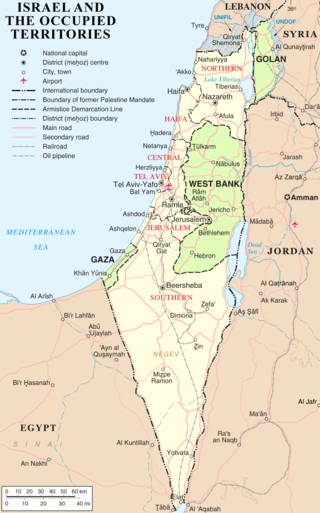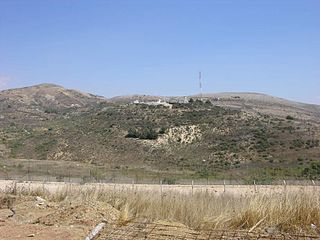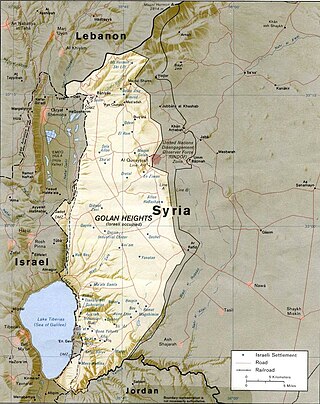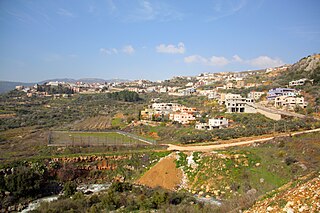
The Shebaa Farms, also spelled Sheba'a Farms, also known as Mount Dov, is a strip of land on the Lebanese–Syrian border that is currently occupied by Israel. Lebanon claims the Shebaa Farms as its own territory, and Syria agrees with this position. Israel claims it is part of the Golan Heights, Syrian territory that it has occupied since 1967 and effectively annexed in 1981. This dispute plays a significant role in contemporary Israel–Lebanon relations.

Buq'ata is a Druze town, administered as a local council, in the northern section of the Israeli-occupied portion of the Golan Heights. Buq'ata covers an area of 7,000 dunams (7 km²) between two mountains in the Golan Heights, Mount Hermonit and Mount Varda. Located 1,070 metres above sea level, it had a population of 6,805 in 2022.

Israel has occupied the Golan Heights of Syria and the Palestinian territories since the Six-Day War of 1967. It has previously occupied the Sinai Peninsula of Egypt and southern Lebanon as well. Prior to 1967, control of the Palestinian territories was split between Egypt and Jordan, which occupied the Gaza Strip and the West Bank, respectively. The Israeli occupation of the Palestinian territories and the Golan Heights, where Israel has transferred parts of its population and built large settlements, is the longest military occupation in modern history.

Majdal Shams is a predominantly Druze town in the Israeli-occupied Golan Heights, located in the southern foothills of Mount Hermon. It is known as the informal "capital" of the region.

Shouting Hill is a hill in the Golan Heights. The hill is located near the Druze village of Majdal Shams, in the area of the Golan that is occupied by Israel. During the Six-Day War, Israel captured most of the Golan Heights. Shouting Hill is located close to the Purple Line, a ceasefire line that separates Syrian and Israeli controlled territory.

Quneitra Governorate is one of the fourteen governorates (provinces) of Syria. It is situated in southern Syria, notable for the location of the Golan Heights. The governorate borders the countries of Lebanon, Jordan and Israel, and the Syrian governorates of Daraa and Rif Dimashq. Its area varies, according to different sources, from 685 km2 to 1,861 km2. The governorate had a population of 87,000 at the 2010 estimate. The nominal capital is the now abandoned city of Quneitra, destroyed by Israel before their withdrawal in June 1974 in the aftermath of the Yom Kippur War; since 1986, the de facto capital is Madinat al-Salam.

The Golan Heights, or simply the Golan, is a basaltic plateau at the southwest corner of Syria. It is bordered by the Yarmouk River in the south, the Sea of Galilee and Hula Valley in the west, the Anti-Lebanon mountains with Mount Hermon in the north and Wadi Raqqad in the east. It hosts vital water sources that feed the Hasbani River and the Jordan River. Two thirds of the area was occupied by Israel following the 1967 Six-Day War and then effectively annexed in 1981 – an action unrecognized by the international community, which continues to consider it Israeli-occupied Syrian territory. In 2024 Israel occupied the remaining one third of the area.

Neve Ativ, is an Israeli settlement in the Golan Heights, organized as a small Alpine-styled moshav. Located on the slopes of Mount Hermon, 2 kilometers (1.2 mi) west of Majdal Shams. it falls under the jurisdiction of Golan Regional Council. In 2022 it had a population of 140.

Annexation, in international law, is the forcible acquisition and assertion of legal title over one state's territory by another state, usually following military occupation of the territory. In current international law, it is generally held to be an illegal act. Annexation is a unilateral act where territory is seized and held by one state, as distinct from the complete conquest of another country, and differs from cession, in which territory is given or sold through treaty.

Israel–Syria relations refer to the bilateral ties between the State of Israel and the Syrian Arab Republic. The two countries have been locked in a perpetual war since the establishment of Israel in 1948, with their most significant and direct armed engagements being in the First Arab–Israeli War in 1948–1949, the Third Arab–Israeli War in 1967, and the Fourth Arab–Israeli War in 1973. Additionally, Israeli and Syrian forces also saw relatively extensive combat against each other during the Lebanese Civil War, the 1982 Lebanon War, as well as the War of Attrition. Both states have at times signed and held armistice agreements, although all efforts to achieve complete peace have been without success. Syria has never recognized Israel as a legitimate state and does not accept Israeli passports as legally valid for entry into Syrian territory; Israel likewise regards Syria as a hostile state and generally prohibits its citizens from travelling there, with some exceptions and special accommodations being made by both countries for Druze people residing in Syria and the Golan Heights. Israel and Syria have never established formal diplomatic relations since the inception of both countries in the mid-20th century.

Before the Six-Day War and Yom Kippur War, the Golan Heights comprised 312 inhabited areas, including 2 towns, 163 villages, and 108 farms. In 1966, the Syrian population of the Golan Heights was estimated at 147,613. Israel seized about 70% of the Golan Heights in the closing stages of the Six-Day War. Many of these residents fled during the fighting, or were driven out by the Israeli army, and some were evacuated by the Syrian army. The Washington Report on Middle East Affairs in 1992 characterized Israel's actions as "ethnic cleansing".
The 2012–2014 Quneitra Governorate clashes began in early November 2012, when the Syrian Army began engaging with rebels in several towns and villages of the Quneitra Governorate. The clashes quickly intensified and spilled into the UN-supervised neutral demilitarized zone between Syrian controlled territory and the Israeli-occupied Golan Heights.

The Agreement on Disengagement between Israel and Syria, which was signed on May 31, 1974, provided for the continuation of the cease-fire already in effect and for the separation of opposing parties by a UN Peacekeeping Force. The Agreement specifically states that “H. This agreement is not a peace agreement. It is a step toward a just and durable peace on the basis of Security Council Resolution 338 dated October 22, 1973.”

Ein Qiniyye or 'Ayn Qunya is a Druze village in the Israeli-occupied southern foothills of Mount Hermon, 750 meters above sea level. It was granted local council status in 1982. Its inhabitants are mostly Syrian citizens with permanent residency status in Israel. In 2022 it had a population of 2,190.
The Quneitra offensive , code-named "Road to Damascus", was a military operation launched by rebel forces against the Syrian Arab Army at the town of Madinat al-Baath, in the Quneitra Governorate, during the Syrian Civil War.

The Golan Heights are a rocky plateau in the Levant region of Western Asia that was captured by Israel from Syria in the 1967 Six-Day War. The international community, with the exception of Israel and the United States, considers the Golan Heights to be Syrian territory held by Israel under military occupation. Following the war, Syria dismissed any negotiations with Israel as part of the Khartoum Resolution.

The Majdal Shams attack, took place on 27 July 2024, when a rocket hit a football pitch in Majdal Shams in the Israeli-occupied Golan Heights. The resulting blast killed 12 Syrian children belonging to the Druze community and injured at least 42 others, with most of the victims being between the ages of 10 and 16.
The 1982 Golan Heights Druze general strike, also known as the Great Strike, was a 5-month general strike by members of the Druze community in the Golan Heights protesting the Israeli annexation of the Golan Heights.















